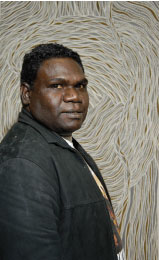- Artist: Gunybi Ganambarr
- Art Centre: Buku Larrnggay Mulka
- Region: Arnhem Land
Artwork Story
Gunybi has mainly lived and worked as an artist at Gånga, sometimes based at Dhuruputjpi or Yilpara. A ceremonial yidaki player who is sought after by elders. Accompanied the Yolngu delegations to the opening of the National Museum in Canberra 2001 and the larrakitj installation at the Sydney Opera House 2002, and played at the opening of Djambawa Marawili’s exhibition in the 2006 Sydney Biennale.
He spent twelve years working as a builder for the Laynhapuy Homelands Association making houses in over ten homeland centres. He eventually moved back to his mother’s homeland at Gangan. Under the tutelage of artists like Gawirri] Gumana and Yumutjin Wunungmurra from his mother’s Dha`wangu clan whilst living on their country he has now assumed ceremonial authority.
He first came to the notice of the Buku-Larrnggay staff as an artist with a carved and painted Ironwood sculpture of a Wurran or cormorant ( a totemic species of his mother clan) in 2002. The wood’s natural shape suggested itself to him and he commenced to reveal the bird within. He then added pigment to achieve the colouring but both sculpting Ironwood for sale (rather than ceremony) and painting Ironwood are new actions in North East Arnhem land public art. This began a consistent theme of Gunybi following his own inclinations in expressing his vision. He has combined that with a startling innovative flair to produce groundbreaking sacred art that is at once novel and still entirely consistent with Yolngu madayin (law). His first recognition in a wider sphere was when he was invited by Brenda Croft of the National Gallery of Australia to enter the National Sculpture Prize in 2005. He submitted one of his first sculpted larrakitj. In the year of 2008 he was chosen as an exhibiting finalist in the Xstrata Coal Emerging Indigenous Artist Award at the Gallery of Modern Art at Queensland Art Gallery. He went on to win that Award.
Gunybi has had the instinct to introduce radical new forms without offending community tolerance. He has introduced or developed novel forms such as double sided barks, heavily sculpted poles, incised barks, ironwood sculpture, inserting sculptures into poles. Gunybi is an energetic participant in ceremonial life who is always cheerful with a robust sense of humour. He is a natural leader amongst his peers. His vigorous zest for life sees him throw himself into whatever activity he is engaged in. He is married to Lamangirra Marawili a daughter of Djambawa Marawili
After his sold out show at Annandale Galleries in Sydney in late 2009 where he received great acclaim and press coverage he returned home with a renewed vigour. He immediately moved into using found materials on his own initiative and with the blessing of his mentors.
In 2011 he won the West Australian Indigenous Art Award. At this time The Australian wrote; ”When Ganambarr was a young man, senior Yolngu artists recognised his ability and ensured he had the skills and knowledge to create the extraordinary bark paintings on show. These wonderfully complex and technically brilliant barks sit alongside new works that exploit the potential of materials found around mining sites. Using the layered webs of lines fundamental to traditional Yolngu painting and the incising of lines that characterises Yolngu carving, he has reclaimed the insulation panels and rubber belts discarded by miners and transformed them into panels that combine traditional image-making with an enhanced sense of visual depth and tangible space.
Ganambarr’s work epitomizes the innovative and exploratory nature of contemporary Aboriginal arts practice and not surprisingly the judges awarded him the $50,000 main prize.” In late 2011 he was awarded a Myer Foundation Creative Fellowship for two years and short-listed for a major public art project in collaboration with Urban Art Projects.
Exhibitions:
2004 Circle line column, Annandale Galleries, Sydney entrant to National Sculpture Competition 2004-5
2005 Telstra NATSIAA MAGNT
2005 National Sculpture Prize and Exhibition NGA
National Sculpture Prize Macquarie Bank Traveling Exhibition first venue QCA Brisbane
2006 Young Guns, Annandale Galleries, Sydney
2007 Galuku Gallery, Festival of Darwin
2007 Bukulungthunmi – Coming Together, One Place, Raft Artspace, Darwin
2007 National Aboriginal and Torres Strait Islander Art Awards, Museum and Art gallery of the NT, Darwin
2008 Important Aboriginal Art, Caruana Reid Fine Art, Sydney, NSW
2008 Young Guns Two, Annandale Galleries. Sydney.
2008 “Bitpit” Yirrkala Sculpture, RAFT Artspace Darwin
2008 Xstrata Emerging Indigenous Artist Award (by invitation), QAG (winner)
2009 Larrakitj – the Kerry Stokes Collection, Art Gallery of Western Australia, Perth
2009 Togart Contemporary Art Award (NT) 2009, Parliament House, Darwin
2009 ‘Prised and Incised’, Annandale Galleries. Sydney
2010 17th Biennale of Sydney, ‘Larrakitj ‘- the Kerry Stokes Collection, Museum on Contemporary Art, Sydney
2010 27th National Aboriginal and Torres Strait Islander Art Awards, Museum and Art Galleries of the Northern Territory, Darwin
2011 28th National Aboriginal and Torres Strait Islander Art Awards, Museum and Art Galleries of the Northern Territory, Darwin
2011 Winner of the West Australian Indigenous Art Award AGWA Perth
2011 TOGART NT Contemporary Art Award, Darwin
2012 New Work Gunybi Ganambarr, Annandale Galleries
2012 National Indigenous Art Triennial NGA
2012 Gan’yu Gallery, Darwin Festival
2013 Found, Annandale Galleries, Sydney
2013 Gapan Gallery, GARMA Festival
2014 31st National Aboriginal and Torres Strait Islander Art Awards, Museum and Art Galleries of the Northern Territory, Darwin.
Collections:
Metropolitan Museum of Art, New York, USA
National Gallery of Australia
South Australian Museum
Queensland Art Gallery
Levi Kaplan Collection, Seattle, WA, USA
Kerry Stokes Collection, Perth, WA
National Museum of Australia , Canberra
© Buku Larrnggay Mulka
